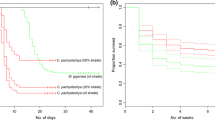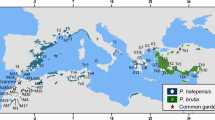Summary
Plant population dynamics and life cycle characteristics are presented for two genetically related, yet ecologically distinct, chromosomal races of Machaeranthera gracilis (Nutt.) Shinners. Seedling mortality was very high for a field population of the desert race (n=2) as only 8% of the maximum number of seedlings produced did survive to the period of peak reproduction. Lower mortality occurred in the foothills race (n=4) as 15% of the maximum number of seedlings produced did survive until the period of peak reproduction. The desert race also exhibited the capacity to assume the perennial growth habit. Perennial plants of the desert race produced 4.4 heads/plant (116 heads/m2) versus 0.2 heads/plant (4 heads/m2) for annual plants of the desert race under field conditions. Annual plants of the foothills race produced 2.7 heads/plant (75 heads/m2). The perennial habit did not occur in field populations of the foothills race. When grown in identical glasshouse conditions the desert race reached anthesis of the first four flower heads ca. 25 days prior to the foothills race. This acceleration to anthesis was accompanied by a greater potential reproductive allocation. The latter response was due in part to greater biomass allocation to reproductive structures at the expense of vegetative structures, and the uncoupling of net photosynthesis from phenological events.
Similar content being viewed by others
References
Abrahamson WG (1979) Patterns of resource allocation in wildflower populations of field and woods. Amer J Bot 66:71–79
Anderson DA (1980) Photosynthesis, biomass and caloric allocation in Machaeranthera gracilis. Master of Science Thesis. Arizona State University
Armond PA, Mooney HA (1978) Correlation of photosynthetic unit size and density with photosynthetic capacity. Carnegie Inst Wash Yearbook 77:234–237
Beatley JC (1967) Survival of winter annuals in the northern Mojave desert. Ecol 48:745–750
Bell KL, Hiatt HD, Niles WE (1979) Seasonal changes in biomass allocation in eight winter annuals of the Mojave Desert. J Ecol 67:781–787
Ehleringer J, Mooney HA, Berry JA (1979) Photosynthesis and microclimate of Camissonia claviformis a desert winter annual. Ecol 60:280–286
Idso SB, Jackson RD, Reginato RJ (1977) Remote-sensing of crop yields. Canopy temperature and albedo measurements have quantitatively correlated with final harvests of wheat. Science 196:19–25
Jackson RC (1964) Preferential segregation of chromosomes from a trivalent in Happlopappus gracilis. Science 145:511–513
Jackson RC, Crovello TJ (1971) A comparison of numerical and biosystematic studies in Happlopappus. Brittonia 23:54–70
Lowe CH (1964) Arizona's Natural Environment. The University of Arizona Press, Tucson
Ludlow MM, Wilson GL (1971) Photosynthesis of tropical pasture plants. III. Leaf age. Aust J Biol Sci 24:1077–1087
Monson RK, Szarek SR (1979) Ecophysiological studies of Sonoran Desert plants. V. Photosynthetic adaptations of Machaeranthera gracilis, a winter annual. Oecologia (Berl) 41:317–327
Mooney HA, Ehleringer J, Berry JA (1976) High photosynthetic capacity of a winter annual in Death Valley. Science 194:332–324
Mulroy TW, Rundel PW (1977) Annual plants: adaptations to desert environments. Bioscience 27:109–114
Pitelka LF (1977) Energy allocation in annual and perennial lupines (Lupinus: Leguminosae). Ecol 58:1055–1065
Primack RB (1978) Reproductive effort in annual and perennial species of Plantago (Plantaginaceae). Amer Nat 114:51–62
Raynal DS, Bazzaz FA (1973) Establishment of early successional plant populations on forest and prairie soil. Ecol 54:1335–1341
Schaffer WM, Gadgil MD (1975) Selection for optimal life histories in plants. In: Cody ML and Diamond JM (eds) Ecology and Evolution of Communities. 142–157
Sokal RP, Rohlf FJ (1978) Introduction to Biostatistics. WH Freeman and Co, San Francisco
Woodward RG, Rawson HM (1976) Photosynthesis and transpiration in dicotyledonous plants. II. Expanding and senescing leaves of soybean. Aust J Plant Physiol 3:257–267
Author information
Authors and Affiliations
Rights and permissions
About this article
Cite this article
Monson, R.K., Szarek, S.R. Life cycle characteristics of Machaeranthera gracilis (Compositae) in desert habitats. Oecologia 49, 50–55 (1981). https://doi.org/10.1007/BF00376897
Received:
Issue Date:
DOI: https://doi.org/10.1007/BF00376897




